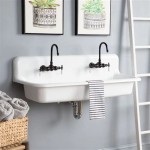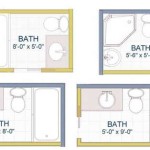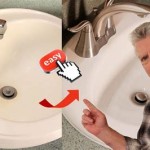Installing a Bathroom Faucet and Drain: A Comprehensive Guide
Replacing a bathroom faucet and drain is a common home improvement project that enhances both the functionality and aesthetics of a bathroom. This task, while seemingly complex, can be accomplished by individuals with basic plumbing knowledge and the right tools. This article provides a detailed, step-by-step guide to installing a new bathroom faucet and drain, ensuring a successful and leak-free installation.
Before commencing the installation process, careful planning and preparation are crucial. This initial phase involves gathering the necessary tools and materials, selecting the appropriate faucet and drain assembly, and understanding the existing plumbing configuration. Rushing this stage can lead to complications and potentially costly mistakes.
The tools required for this project typically include: an adjustable wrench, a basin wrench (also known as a faucet wrench), a pipe wrench, a screwdriver (both Phillips head and flathead), pliers, a putty knife, plumber's putty, Teflon tape (also known as pipe thread seal tape), a bucket, towels, and safety glasses. Having all tools readily available streamlines the process and minimizes interruptions.
The choice of faucet and drain assembly depends on the existing sink configuration and personal preferences. Faucets are available in various styles, including single-hole, centerset, and widespread designs. The drain assembly must be compatible with the faucet and the sink's drain opening. Consider the finish of the faucet and drain to complement the bathroom's overall design. Ensure that the new faucet and drain comply with relevant plumbing codes and regulations.
Finally, before starting any plumbing work, it is essential to shut off the water supply to the bathroom. The shut-off valves are typically located under the sink. If these valves are not present or are not functioning correctly, the main water supply to the house must be shut off. Once the water is shut off, open the existing faucet to relieve any remaining pressure in the pipes.
Step 1: Removing the Old Faucet and Drain
The first physical step involves removing the existing faucet and drain. This requires disconnecting the water supply lines, loosening the faucet mounting nuts, and disassembling the drain assembly. The process can be messy, so it's advisable to have a bucket and towels nearby to catch any residual water.
Begin by disconnecting the water supply lines from the existing faucet. Use an adjustable wrench to loosen the connections. If the connections are corroded or difficult to loosen, penetrating oil can be applied to help break them free. Once the connections are loosened, carefully disconnect the water supply lines, ensuring that the bucket is positioned to catch any remaining water in the lines.
Next, locate the faucet mounting nuts, which are typically located underneath the sink and secure the faucet to the sink. These nuts can be difficult to reach, necessitating the use of a basin wrench. A basin wrench is designed with a long handle and a swiveling jaw, allowing it to access tight spaces. Loosen the mounting nuts and remove the faucet from the sink.
With the faucet removed, the drain assembly can be disassembled. The drain assembly typically consists of a tailpiece, a pivot rod, a pop-up stopper, and a drain flange. Start by loosening the pivot rod nut, which connects the pivot rod to the drain tailpiece. Once the pivot rod is disconnected, the pop-up stopper can be removed from the drain opening.
Next, loosen the nut connecting the tailpiece to the drain flange. The tailpiece is the vertical pipe that connects the drain to the P-trap. Once the nut is loosened, the tailpiece can be removed. Finally, the drain flange, which is the part of the drain assembly that sits on top of the sink, can be removed. This may require using a putty knife to gently break the seal between the flange and the sink.
After removing all components of the old faucet and drain, thoroughly clean the sink surface. Remove any old plumber's putty or sealant using a putty knife. Ensure that the sink surface is clean and dry before proceeding to the next step. Inspect the drain opening for any damage or corrosion. If necessary, repair or replace the sink before installing the new faucet and drain.
Step 2: Installing the New Faucet
The installation of the new faucet involves connecting the water supply lines, mounting the faucet to the sink, and securing the faucet in place. Careful attention to detail is crucial during this phase to ensure a leak-free installation.
Begin by attaching the water supply lines to the new faucet. The faucet may come with pre-attached water supply lines, or separate supply lines may need to be purchased. If separate supply lines are required, ensure that they are the correct length and type for the existing plumbing. Apply Teflon tape to the threads of the faucet connections before attaching the water supply lines. Teflon tape helps to create a watertight seal. Tighten the connections securely using an adjustable wrench.
Next, position the faucet on the sink, aligning it with the mounting holes. The faucet may come with a rubber gasket or O-ring that should be placed between the faucet and the sink to create a watertight seal. From underneath the sink, attach the mounting hardware. This typically involves installing mounting nuts and washers onto the faucet shanks. Tighten the mounting nuts securely using a basin wrench. Ensure that the faucet is level and properly aligned before fully tightening the nuts.
After the faucet is securely mounted, double-check all connections to ensure that they are tight and leak-free. Turn on the water supply slowly and inspect for any leaks around the faucet connections and the water supply lines. If any leaks are detected, tighten the connections further or reapply Teflon tape as needed.
Consider installing new shut-off valves if the existing valves are old or corroded. New shut-off valves provide a reliable means of shutting off the water supply in the event of future repairs or emergencies. To install new shut-off valves, shut off the main water supply to the house and disconnect the existing valves. Attach the new valves to the water supply pipes, using Teflon tape on the threads.
Step 3: Installing the New Drain
Installing the new drain involves assembling the drain components, applying plumber's putty to the drain flange, and connecting the drain to the P-trap. Proper installation is essential to prevent leaks and ensure efficient drainage.
Begin by assembling the drain components according to the manufacturer's instructions. The drain assembly typically includes a drain flange, a rubber gasket, a friction washer, a cardboard washer, and a mounting nut. Roll a rope of plumber's putty and place it around the underside of the drain flange rim. The putty should be applied evenly to create a watertight seal between the flange and the sink.
Insert the drain flange into the drain opening of the sink. From underneath the sink, install the rubber gasket, friction washer, and cardboard washer onto the drain flange. Tighten the mounting nut securely by hand. Then, use a wrench to tighten it further until the plumber’s putty extrudes slightly. Clean away excess putty with a putty knife.
Next, attach the tailpiece to the drain flange. Slide the nut and friction washer on to the tailpiece and attach it to the bottom of the drain flange on the underside of the sink. Tighten the nut and ensure a tight fit.
Install the pivot rod and pop-up stopper. Insert the pop-up stopper into the drain opening from above, ensuring that it is properly aligned. Connect the pivot rod to the drain tailpiece, tightening the pivot rod nut. Test the pop-up stopper mechanism to ensure that it functions properly.
Finally, connect the drain tailpiece to the P-trap. The P-trap is the curved pipe that connects the drain to the waste pipe. Ensure that the connections are tight and leak-free. Turn on the water supply and check for any leaks around the drain connections. If any leaks are detected, tighten the connections further or reapply plumber's putty as needed.
After the installation is complete, thoroughly clean the area around the sink. Remove any debris or tools. Inspect the installation again after a few hours to ensure that there are no leaks. Regularly check the faucet and drain for any signs of leakage.

How To Install Bathroom Sink Drain Faucet No Leaks Under Gasket Threads Solved 2025

How To Install A Bathroom Faucet The Home

How To Install A Bathroom Sink Drain With Faucet Macy Bath Co Ltd

How To Replace And Install A New Bathroom Faucet Pop Up Drain In 7 Minutes Builds By Maz

How To Install A Bathroom Faucet The Home

How To Replace A Bathroom Sink Drain

How To Install A Bathroom Faucet Hometips

10 Tips For Installing A Faucet The Easy Way Family Handyman

How To Install A Bathroom Faucet The Home

How To Replace A Faucet Diy Guide Ahs







